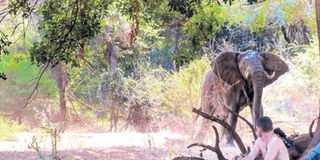Breaking News: At least 10 feared to have drowned in Makueni river
Walking safaris: A trek on the wild side

Being on foot with an expert guide allows you to get the sensory experience and thrill of spending time with the animals, especially ‘Big 5’. PHOTO| ANDREAS FOX
What you need to know:
In many African countries, a walking safari must be led by a guide or scout armed with a rifle. While most incidents occur as a result of negligence or incitement, occasionally animals attack unprovoked.
Ultimately, the safety of clients is paramount, and so firearms-training forms part of many a course.
A few weeks ago, I wrote an article about the wonders of Mashatu in eastern Botswana with a promise to follow up with a story on walking safaris. I am lucky to be back here for a few weeks helping run courses for prospective walking (trails) guides.
Ecotraining’s camps section on Mashatu features a combination of terrific ridges, open plains, thick riverine vegetation, marshes and a glut of wildlife – elephants, lions, leopards and hyenas, both spotted and brown. It’s these creatures that the course aims to teach students how to approach safely and ethically.
A walking safari is not only about approaching animals, however. While guests may ultimately want to experience the thrill of spending time with wild members of the “Big 5”, this is a bonus.
Being on foot with a professional guide allows you to take full advantage of the sensory experience and it gives access to detailed aspects of nature that a vehicle-based safari cannot match. It can be terrifying, exhilarating, therapeutic and relaxing – all at the same time. While most of our lifestyles are far removed from the primal experiences of our ancestors and certain tribal cultures, many people describe how such walking experiences connect them to something innate.
These spiritual dynamics led the late Dr Ian Player to set up the Wilderness Leadership Foundation. With his Zulu mentor, Magqubu Ntombela, they developed multi-day wilderness trails through Hluhluwe-Imfolozi. On these trails, guests, business figures, local youth and prospective leaders are mentored and encouraged to self-discover the importance of such areas to the human psyche and environmental conservation.
Carrying all their food, searching for water and negotiating unforgiving terrains and wild animals, the groups look for a safe spot each evening. Without tents, they sleep rough: creating a small fire, cooking their rations. They settle into a rota system, where each person spends part of the night awake and alone keeping watch over their team and, telling by the moon and stars.
Dr Player considered this period of solitude and responsibility pivotal to his concept. Having been on such wilderness trails, I can attest to its effect, both professionally and personally. As a current mentor of mine often says, “It’s not just what we can learn about nature, but about what nature can teach us about ourselves.”
But the aim of a trails’ guide course is a lot more basic. Initially, we need to ensure prospective walking guides have the skills to safely walk with guests in areas with potentially dangerous animals. Certainly, animal behaviour is a huge component, but ‘situational awareness’ is a constant theme. This is the ability to read the conditions and understand subtle signs, such as fresh tracks or the alarm calls of particular species that could indicate the presence of a predator.
Using the wind, sunlight and vegetation to your advantage, you can safely approach numerous animals, sometimes to within metres of them – and then leave without them knowing you were there. To me, there are few more visceral experiences than being on foot, peacefully watching animals such as elephants behave undisturbed.
This is the ultimate goal of any ethical trails guide. However, not every encounter will go this way, and students need to be knowledgeable of how to avoid, but also deal with, a critical situation. Especially, never run — no matter how much your instinct tells you to.
MUST BE LED BY GUIDE
In many African countries, a walking safari must be led by a guide or scout armed with a rifle. While most incidents occur as a result of negligence or incitement, occasionally animals attack unprovoked. Ultimately, the safety of clients is paramount, and so firearms-training forms part of many a course.
Nevertheless, Kenya seems to have an under-developed walking safari industry. While walking is impossible in national parks, with a few exceptions, most current options operate on private or community land and conservancies. Some lodges in these areas offer walking, but as short alternatives to game drives or as a ‘cultural’ experience.
Specialist walking operators are seemingly rare — I know I must be missing a few but, other than the well established mountain climbing packages, there are a few walking operations in Laikipia, the odd camel trekking safari and the amazing “Great Walk of Africa” across Tsavo East with Iain Allen.
Kenya has areas that would be ideal for this concept, offering fantastic game viewing on foot, but also as cultural experiences and community conservation initiatives. Just as Dr Player intended, Kenyans would also have to be afforded the opportunity to join, learn and hopefully carry the lessons forward. I would love to get involved. For more information about Ecotraining, check the website, www.ecotraining.co.za
The writer is an Associate Consultant with iDC





